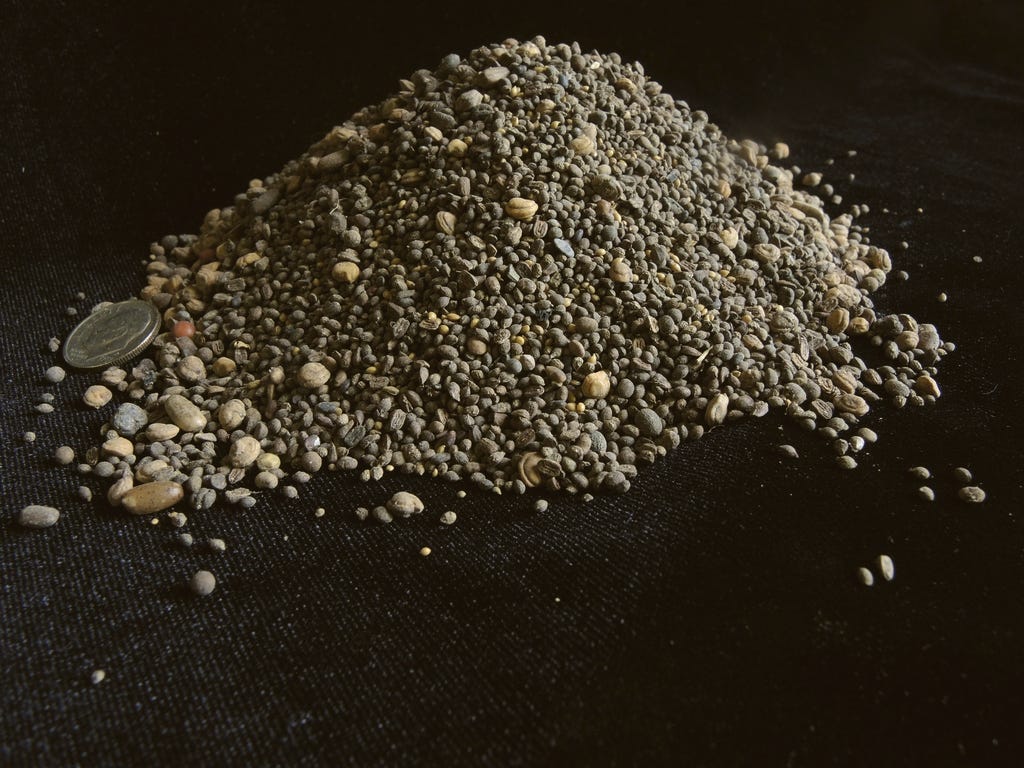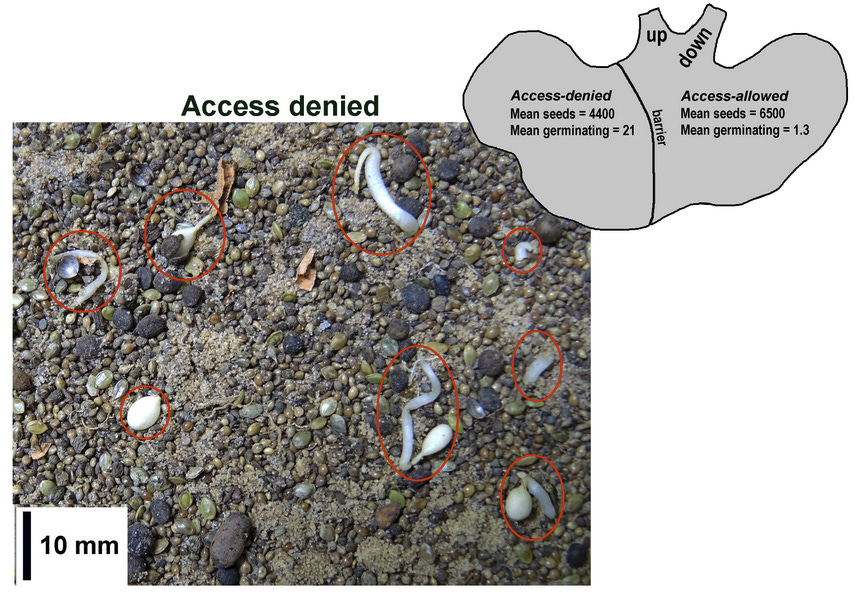People have invented an entire story of human progress in which people invented various new ways of wresting a living from the environment, starting with eating fruits and leaves, to hunting/gathering, to herding, to farming and, who knows what, beyond. But humans are Johnny-come-latelies compared to ants (among others). Eating fruit doesn’t take any special talent, but the other modes do. Species of ants hunt and gather, many herd “cattle” and a large number farm. The Found Objects for this essay come from the Florida harvester ant, Pogonomyrmex badius, an ant that both hunts and gathers. As a gatherer, it finds and collects seeds, and stores them in the nest for future consumption. Once again, just as in my essay on Pheidole adrianoi’s sclerotia, the harvester ant’s Found Objects became secondarily mine, as in the image below (why collect my own when I can just purloin them from ants, right?).

Gathering and storing seeds is a behavior that has evolved independently several times among ants, especially in arid or semi-arid habitats. In the genus Pogonomyrmex, all the species collect seeds to varying degrees. The Florida harvester ant, even here in the moister east, is found mostly in sandy and very dry habitat.
To find out what kind of seeds and how many the ant stores is a simple matter of excavating nests carefully, level by level, all the way down to 2 or 3 meters depth. The seeds are usually stored in chambers between 40 and 100 cm depth. Despite the many times I have exposed seed chambers, I still feel a sense of amazement and pleasure every time.

The total seeds collected increases with colony size (not surprising), from about 50 in an infant colony to over 300,000 in some mature colonies. About 50 different species of seeds can be found in the stores, but 8 or 10 species make up 95% of the numbers. A closer view (below) reveals the wide range of seed sizes.

Like everyone else who works on harvesting ant species, I assumed that when the ants want to eat a seed, they simply crack the seed coat, mash the enclosed endosperm into a pulp and form it into “ant bread” for their larvae (easily observed in lab nests). Although there is a huge range of seed sizes, it wasn’t until years later that I started wondering how (or if) the ants managed to open the big ones. In the image below, consider (as I finally did) the size of the larger seeds, and the size of both the ants and their mandibles, and ask yourself, how do they get into those big ones? They can’t use hammers or axes because a hammer that small would lack the kinetic energy to crack the coat. If they can’t get them between their mandibles, how could they crack them? Wearing a hole would also wear their mandibles. Maybe milling seeds is the function of the large (aka major) workers, but looking at the image below, even these don’t seem big enough.

So, the first question to answer is not how they open the seeds, but whether they do. The fact that ants discard seed husks in their trash piles suggested an experiment. I offered lab and field ant colonies seeds of four different sizes, each marked with a different color of fluorescent printers’ ink, and then checked the trash pile with an ultraviolet light. Marked seed husks shone like beacons, and the color identified the size.

The ants collected all sizes of seeds, but only the husks of the two small sizes appeared with any frequency in the trash. Almost no husks of large seeds appeared. It also didn’t matter if the lab colony included major workers or not--- only smaller seeds were opened and used. In the image below, seed species are arranged in order of increasing size, with can-open seeds indicated. Seeds larger than about 1.4 mm cannot be opened by the ants.

The inescapable fact was that colonies stored huge numbers of seeds of a size they couldn’t open. Moreover, when the colony moved to a new nest (as they do on average once a year), they moved all the seeds too. Estimating the proportion of seeds in the can-open and the cannot-open categories showed that an average of 70% of the weight of seeds were in the cannot-open category.
On the other hand, inspecting the seed husks in the trash of field colonies showed that the great majority of husks came from the smaller seeds in the can-open category, suggesting that cannot-open seeds accumulate in the colonies over time. In other words, because ants forage continuously, there is a high turnover in the can-open seeds, but a low turnover in the cannot-open seeds, causing them to accumulate.

Like many before me, I have wondered how harvesting ants keep the seeds from germinating in their moist underground chambers. It should have tipped me off that seeds buried in ant-free chambers germinated with some regularity. Finally, one day, like St. Paul on the road to Damascus, I saw a blinding light that illuminated a big sign that said, “They are not keeping them from germinating, you moron, they are waiting for them to germinate!” And of course, even a large seed can be easily chopped up and eaten after it germinates!
The test was to dye germinating seeds with the fluorescent dye rhodamine B and non-germinating seeds with methylene blue, offer them to ants in lab and field colonies, and then check if the larvae had ingested either color of dye.

Whether in the lab or the field, larvae quickly fluoresced bright orange, but none showed any trace of blue. Aha! A clear answer, as in the image below.

Of course, this is all well and good, but if the seeds don’t germinate in the chambers, and the ants don’t remove and eat them, this could be a mere artifact, like feeding eclairs to polar bears. The logical test was to divide underground seed chambers into two parts--- one to which the workers had access and from which germinating seeds could be harvested, and the other without access, in which germinating seeds should accumulate.
From a pit next to each colony, we dug laterally until we had just nicked a seed chamber, whereupon we inserted a metal barrier that divided the chamber into access and no-access parts (there is only one entrance to each chamber). After a couple of weeks, we harvested the seeds from the two parts and found that, indeed, germinating seeds occurred far more frequently in the no-access part than the access part. The workers removed the seeds as soon as they germinated and fed them to larvae.

We followed this insight up with an elaborate study of seasonal, temperature and species patterns of germination. Temperature seemed to be a dominant factor with germination favored by high or low temperatures in different species, so that some species of seeds germinated mostly in spring and summer, others in fall and winter, but no species showed 100% germination under any circumstances.
What comes into view then, is that these ants are gambling on a resource that has a cost in the present, but might pay off in the future, although the date and cost of that pay-off can’t be pinned down with any confidence— betting on a long-shot horse can pay hugely if it wins, but might also be a waste of money. The largest seeds that the ants can readily open are just over 1 mm wide and average about 0.8 mg in weight. A 2 mm wide seed cannot be opened but averages about 7.3 mg, containing nine times as much nutrition as the 1 mm seed. Large seeds can easily weigh 15 times as much as small ones, so the payoff would be approximately the same if the large seed germinated in the time it took to collect, open and consume 15 small ones. This basic game misses some of the subtleties. Seasonal and species patterns complicate the calculations, as does the residence time in the seed chambers. Do ants cull seeds that haven’t germinated in years? Can they tell if a newly-collected seed has lain dormant for long enough to increase the likelihood it will sprout? Can they judge the environmental and seasonal conditions under which their mix of seeds will germinate?
Is P. badius is smarter than the average ant because it games a system dominated by chance? Perhaps, but in a wide sense, all of life is a game of chance, and the life that exists today has played the game successfully over a very long run. Evolution produces adaptations and behaviors that tilt the game in a creature’s favor if positive and/or negative chance can be titrated against benefit/cost. Harvester ants pay a cost in time and lost foraging opportunity to collect really large seeds because the benefit of doing so is large even though the chance is small. We too have many ways to bet on the future, both personally and as societies. Are we better at it than the ants?



I enjoy, and am fascinated by, how you can find evidence in the field of what these ants do, and dive deeper to discover how and why they do it. I realize this is the world of a myrmecologist but does it teach us something broader? I am a former journalist who sometimes got a great story by examining what others missed, but also realize now how much I should looked deeper or differently at what’s going on.
Very well explained for some of us novices. I was taken by the search for knowledge, here obviously more valuable than the financial benefit to the searcher. At times my brother and I have had discussions about public policy and sparred a bit with some who are far more focused on "all about the money" and dismissive of science for its own sake. I am trying to calculate how to make the money focused get a glimpse of the impressive effort spent by scientists to advance learning and share that knowledge with others. This sort of knowledge digging and sharing can go a long way toward exalting science without necessarily consideration of the monetary side.